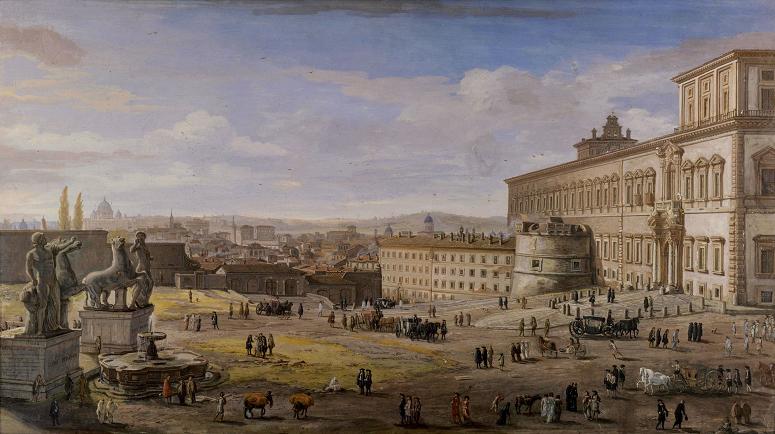Quirinal Palace. The Quirinal Palace is a historic building in Rome, Italy, one of the three current official residences of the President of the Italian Republic, together with Villa Rosebery in Naples and Tenuta di Castelporziano in Rome. It is located on the Quirinal Hill, the highest of the seven hills of Rome in an area colloquially called Monte Cavallo. It has housed thirty Popes, four Kings of Italy and twelve presidents of the Italian Republic. The Quirinal Palace was selected by Napoleon to be his residence par excellence as Emperor. However his permanence never took place because of the French defeat in 1814 and the subsequent European Restoration. The palace extends for an area of 110,500 square metres and is the ninth-largest palace in the world in terms of area. The current site of the palace has been in use since Roman times, as excavations in the gardens testify. On this hill, the Romans built temples to several deities, from Flora to Quirinus, after whom the hill was named. During the reign of Constantine the last complex of Roman baths was built here, as the statues of the twins Castor and Pollux taming the horses decorating the fountain in the square testify. The Quirinal, being the highest hill in Rome, was very sought after and became a popular spot for the Roman patricians, who built their luxurious villas. An example of those are the remains of a villa in the Quirinal gardens, where a mosaic, part of the old floor has been found. The palace, located on the Via del Quirinale and facing onto the Piazza del Quirinale, was built in 1583 by Pope Gregory XIII as a papal summer residence. The pope, who wanted to find a location which was far away from the humidity and stench coming from the river Tiber and the unhealthy conditions of the Lateran Palace, chose the Quirinal hill as it was one of the most suitable places in Rome. On the site, there was already a small villa owned by the Carafa family and rented to Luigi d'Este. The pope commissioned the architect Ottaviano Mascherino to build a palace with porticoed parallel wings and an internal court. The project was not fully completed due to the death of the pope in 1585 but it is still recognisable in the north part of the court, especially in the double loggia facade, topped by the panoramic Torre dei venti or Torrino. To the latter, a bell tower was added according to a project by Carlo Maderno and Francesco Borromini. Pope Paul V commissioned the completion of the work on the main building of the palace. The Palace was also used as the location for papal conclaves in 1823, 1829, 1831, and 1846. It served as a papal residence and housed the central offices responsible for the civil government of the Papal States until 1870. In September 1870, what was left of the Papal States was overthrown. About five months later, in 1871, Rome became the capital of the new Kingdom of Italy. The palace became the official royal residence of the Kings of Italy, though some monarchs, notably King Victor Emmanuel III actually lived in a private residence elsewhere, the Quirinale being used simply as an office and for state functions. The monarchy was abolished in 1946 and the Palace became the official residence and workplace for the Presidents of the Italian Republic. Still, some declined the Colle residence and kept their usual Roman residence: for example, Sandro Pertini preferred his old flat near the Trevi Fountain. The facade was designed by Domenico Fontana. Its Great Chapel was designed by Carlo Maderno. It contains frescos by Guido Reni, but the most famous fresco is the Blessing Christ by Melozzo da Forli, placed over the stairs. Its grounds include a famous set of gardens laid out in the 17th century. The palace is composed of the main building, which is built around the majestic courtyard, with the most beautiful halls of the complex environments that serve as representative of the Presidency of the Republic, while the offices and apartments of the head of state are housed in buildings at the bottom of the Manica Lunga, on the long side via del Quirinale, the top of which lie the opulent imperial apartments, which were specially arranged, decorated and furnished for two visits of Kaiser Wilhelm II and which now houses the monarchs or foreign heads of state visiting the President of the Republic. The palace, in its totality, has 1,200 rooms.
more...














